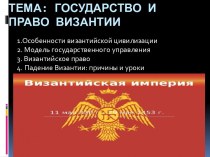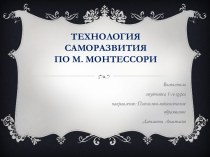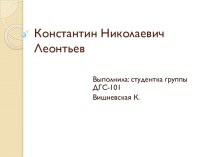- Главная
- Разное
- Бизнес и предпринимательство
- Образование
- Развлечения
- Государство
- Спорт
- Графика
- Культурология
- Еда и кулинария
- Лингвистика
- Религиоведение
- Черчение
- Физкультура
- ИЗО
- Психология
- Социология
- Английский язык
- Астрономия
- Алгебра
- Биология
- География
- Геометрия
- Детские презентации
- Информатика
- История
- Литература
- Маркетинг
- Математика
- Медицина
- Менеджмент
- Музыка
- МХК
- Немецкий язык
- ОБЖ
- Обществознание
- Окружающий мир
- Педагогика
- Русский язык
- Технология
- Физика
- Философия
- Химия
- Шаблоны, картинки для презентаций
- Экология
- Экономика
- Юриспруденция
Что такое findslide.org?
FindSlide.org - это сайт презентаций, докладов, шаблонов в формате PowerPoint.
Обратная связь
Email: Нажмите что бы посмотреть
Презентация на тему International tax law & tax treaties
Содержание
- 2. AgendaIntroductionDomestic tax systems for cross border activitiesTax treatiesRole of tax treatiesApplication and interpretation issues
- 3. International Tax SystemsJurisdiction to Tax (Principles*) Residence
- 4. Concept of ResidenceResidence PrincipleThe jurisdiction to tax
- 5. Concept of SourceSource PrincipleThe jurisdiction to tax
- 6. Potential DifficultyIssues with determining/defining source…BANKINVESTORINVESTMENTSTATE ASTATE BSTATE CLoanInterest
- 7. Design of International Tax SystemsWorldwide Taxation SystemA
- 8. Design of International Tax SystemsTerritorial Tax SystemA
- 9. IntroductionTaxation of Cross Border Activities
- 10. ExampleSTATE BSTATE ABrett, a Citizen of State
- 11. Cross Border Business ActivitiesState RState SPETax consequences
- 12. Business Activities - SubsidiaryState RState STax consequences
- 13. Cross Border Employment PCOSCOJohn is seconded to
- 14. Taxation of cross-border equity investments Final or
- 15. State RState SCross border debt investments Country
- 16. Income from immovable propertyState SState RTaxation on
- 17. Types of Double TaxationI) Juridical Double Taxation
- 18. Quiz: Juridical or Economic?COMPANY ACOMPANY A(a)(b)STATE X
- 19. Approaches to Double Tax ReliefCapital Import NeutralityNeutrality
- 20. Tax Treaties
- 21. Taxation of Cross Border ActivitiesIssue: Double TaxationWhy is it an issue?Solutions?
- 22. Taxation of Cross Border ActivitiesTax treaties as
- 23. Tax TreatiesVienna Convention on the Law of
- 24. Tax TreatiesRelation Treaties (International Law) – Domestic lawMonismDualism
- 25. Place of Treaties in the Legal Systems Place
- 26. Vienna Convention on the Law of TreatiesArticle
- 27. Tax Treaties - ObjectivesGeneral: Facilitate cross-border trade and investment eliminating tax impediments
- 28. Tax Treaties - ObjectivesOperational:Elimination of double taxationPrevention of tax evasion
- 29. Tax Treaties - ObjectivesAims of tax treaties“The
- 30. Tax Treaties - Objectives© 2010 IBFD International Tax AcademyAncillary:Elimination of discriminationExchange of informationAdministrative assistanceResolve disputes
- 31. Process of Establishment A tax treaty
- 32. Model ConventionsWhat is a Model Convention?What is
- 33. Model ConventionsLeague of Nations Models 1928 –
- 34. ModelsOECDUN USA
- 35. ModelsOECD MCDraft 1963Revised 1977, 1992, 1994, 1997, 2000, 2002, 2008, 2010, 2014...Commentaries Favours capital exporting countries
- 36. ModelsUN Model TreatyFirst published 1980Revised 2001Revised 2011Commentary
- 37. ModelsOECD vs UN Model TreatyUN Model follows
- 38. ModelsUS Model Treaty (1996, 2006, 2016)Reflects USA
- 39. TAX TREATIES - ContentCoverage, Scope and Legal
- 40. Content/ Chapters in a Model Tax TreatyI.
- 41. Application and interpretation of tax treaties
- 42. 1ST STEP: Domestic LawWhich countries want to
- 43. Person (Art. 3(1) (a)): individual, company and
- 44. Art. 4: Resident Art. 4 OECD/UN ModelStarting point
- 45. Treaty applicable to: Permanent establishments?Entities generally (characterization:
- 46. Art. 2(1) OECD: taxes on income (and
- 47. Contracting State:Land territoryTerritorial watersContinental shelfExclusive economic zone Art. 29:Territorial Scope
- 48. 3rd STEP: Which distributive rule is applicable?Purpose:
- 49. OECD Model Taxation RightsResidence StateSource StateArts. 12,
- 50. Article 12(1) OECD Royalties arising in a Contracting
- 51. Article 10 OECDPara. 1 Dividends paid by a
- 52. Article 6(1) OECD Income derived by a resident
- 53. Article 19(1) OECD Salaries … paid by a
- 54. 4th STEP: Interpretation Issues?Customary lawVienna Convention on the Law of Treaties (VCLT)
- 55. Meaning of TermsArticle 31Interpreted in good faith
- 56. 4th STEP: Interpretation Issues?Art. 31(1) of the
- 57. TAX TREATIESArt. 31(2) of the VCLT:The context
- 58. TAX TREATIESArt. 31(3) of the VCLT:There shall
- 59. TAX TREATIESArt. 32 of the VCLT: “Recourse may
- 60. 4th STEP: Interpretation Issues?Chapter II and III
- 61. Internal Rule of Interpretation - Article 3(2)OECD
- 62. 4th STEP: Interpretation Issues?OECD MC. Interpretation CommentariesReservationsObservations
- 63. 4th STEP: Interpretation Issues?Legal status of the
- 64. Role of OECD CommentaryMuch debated!!Qualify as supplementary
- 65. 4th STEP: Interpretation Issues?OECD & UN Models:Internal rule of interpretation Art. 3(2) & CommentariesStatic approachAmbulatory approach
- 66. Supplementary Means of InterpretationArticle 32 of Vienna
- 67. 5th STEP: Distributive Rule and ReliefThree possible
- 68. Article 23 – Elimination of Double TaxationExemption methodFull exemptionExemption with progressionCredit methodFull creditOrdinary credit
- 69. Example of Exemption with Progression Mariette has a
- 70. Example How much will Mariette pay and where?
- 71. Example of Credit MethodDividends received: 100WHT in
- 72. Recap of Tax Treaty ApplicationStep 1: Domestic
- 73. Скачать презентацию
- 74. Похожие презентации
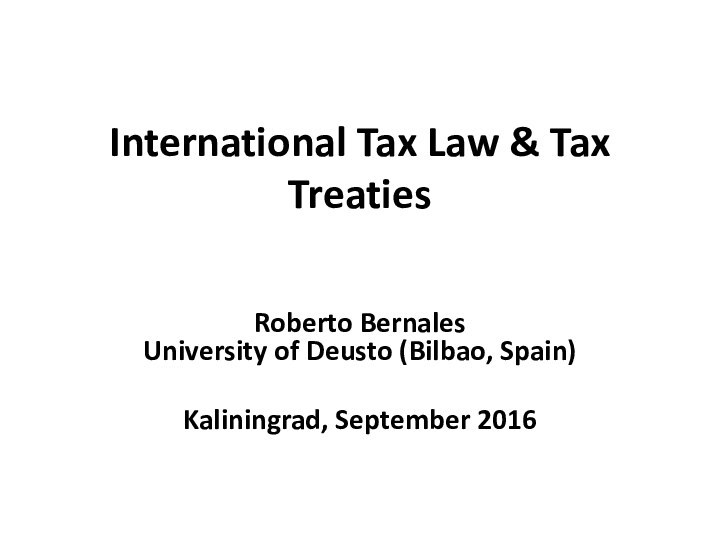







































































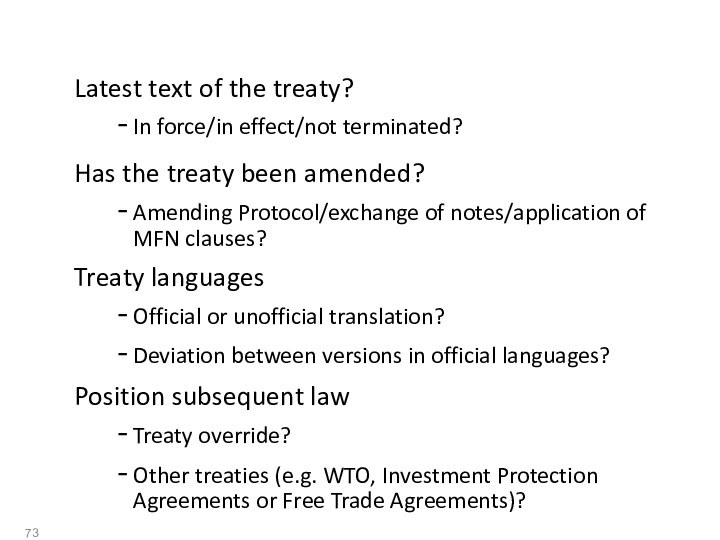
Слайд 2
Agenda
Introduction
Domestic tax systems for cross border activities
Tax treaties
Role
of tax treaties
Слайд 3
International Tax Systems
Jurisdiction to Tax (Principles*)
Residence
Source
Tax
Systems
Worldwide
Territorial
*These are the two main ways in
which States exercise their jurisdiction to tax, but there exists other ways in which a State may exercise its jurisdiction to tax – such as the United States, that taxes its ‘citizens’ on worldwide income.
Слайд 4
Concept of Residence
Residence Principle
The jurisdiction to tax is
based on a connection between the person/entity and the
StatePhysical
Presence
Personal
Attachment
Economic
Ties
Citizen
Place of
Management
Incorporation
CM&C
Head Office
Sets of Criteria
Formal
Factual
Слайд 5
Concept of Source
Source Principle
The jurisdiction to tax is
based the income being from a source within the
StateExamples
Physical location of asset
Where capital is invested
Where the payer resides
Where the contract is signed
Слайд 6
Potential Difficulty
Issues with determining/defining source…
BANK
INVESTOR
INVESTMENT
STATE A
STATE B
STATE C
Loan
Interest
Слайд 7
Design of International Tax Systems
Worldwide Taxation System
A State
subjects to tax:
Residents on their worldwide income
(i.e. income from all sources)Non-Residents on income derived from sources within the State
This is the most common tax system around the world
Examples: Australia, New Zealand, Italy, German, Spain, UK, Canada and many more…
Слайд 8
Design of International Tax Systems
Territorial Tax System
A State
subjects to tax both residents and non-residents on income
derived from sources within the State
Example: Hong Kong
Слайд 10
Example
STATE B
STATE A
Brett, a Citizen of State A,
is transferred by his employer to its subsidiary in
State B for a 2 year period.State A and State B both operate worldwide taxation systems.
Brett’s income steams include:
Interest on deposit with a Bank in State A
Rental income from his property in State A
Employment income
What are the tax issues that may arise for Brett?
Слайд 11
Cross Border Business Activities
State R
State S
PE
Tax consequences in
State S depends on
Concept of “source”
Threshold requirements
Profit measurement rulesTax treaties
Слайд 12
Business Activities - Subsidiary
State R
State S
Tax consequences in
State S:
Subsidiary resident in State S?
Resident taxable
on worldwide income, etc.Tax consequences in State R:
Subsidiary resident in State R or S?
CFC rules?
Слайд 13
Cross Border Employment
PCO
SCO
John is seconded to a
client of PharmaCo for 4 months in order to
train the staff of the client for the use of new software.Residence State
Work State
Слайд 14
Taxation of cross-border equity investments
Final or refundable
Shareholders
Taxation
on worldwide income
Withholding tax
State S
Country of source
of the
incomeState R
Country of residence
of the recipient
Corporate income tax
Company
DIVIDENDS
Слайд 15
State R
State S
Cross border debt investments
Country of
source
of the income
Country of residence
of the recipient
Bank A
LOAN
$100
million
INTEREST
5% p.a.
B
CoTaxation on worldwide income
Withholding tax
Слайд 16
Income from immovable property
State S
State R
Taxation on source
income
Taxation on worldwide income
John
RENT
DOUBLE
TAXATION
Country of residence
of the recipient
Country
of sourceof the income
Gross WHT
Net rental income
Слайд 17
Types of Double Taxation
I) Juridical Double Taxation (JDT)
The
same taxpayer is taxed twice on the same income
II)
Economic Double Taxation (EDT)More than one taxpayer is taxed on the same income (e.g. distributed profits)
Слайд 18
Quiz: Juridical or Economic?
COMPANY A
COMPANY A
(a)
(b)
STATE X CORPORATE
TAX
PAID = $30
STATE Y INDIVIDUAL
INCOME TAX PAID= $40
STATE
X INDIVIDUAL INCOME TAX PAID = $30
STATE Y INDIVIDUAL
INCOME TAX PAID = $30
STATE X
STATE X
STATE Y
STATE Y
DIVIDEND
DIVIDEND
STATE X CORPORATE
TAX PAID = $30
Слайд 19
Approaches to Double Tax Relief
Capital Import Neutrality
Neutrality is
viewed from the perspective of the State where the
investment is made. The same tax burden should apply to foreign investors as to local investors investing in the same StateCapital Export Neutrality
Neutrality is viewed from the perspective of the residence State of the investor – the same tax burden should apply to companies investing abroad as those investing domestically
Слайд 22
Taxation of Cross Border Activities
Tax treaties as a
solution?
Agreement between States (Contracting States)
Avoidance of Double Taxation
Coordinate
the exercise of taxing rights by the Contracting States (allocation of taxing rights)Although it is an agreement between the States, it has direct effect towards taxpayers – “invoke treaty benefits”
Слайд 23
Tax Treaties
Vienna Convention on the Law of Treaties.
Art. 2:
A treaty is an international agreement in one
or more instruments, whatever called concluded between states and governed by international law
Слайд 25
Place of Treaties in the Legal Systems
Place of
treaties in the legal system of a state depends
on the country’s view on international lawMost countries: treaty prevails over domestic law
Some countries (e.g. US): treaty equals domestic law
States in EU are free to conclude tax treaties
But in case of conflict, EU law prevails over tax treaties
Слайд 26
Vienna Convention on the Law of Treaties
Article 26
VCLT Pacta sunt servanda
Binding and must be performed in
good faithOECD report on Tax Treaty Override (1989)
No treaty override
Seek bilateral or multilateral solutions to tax treaty problems
Слайд 27
Tax Treaties - Objectives
General:
Facilitate cross-border trade and
investment eliminating tax impediments
Слайд 28
Tax Treaties - Objectives
Operational:
Elimination of double taxation
Prevention of
tax evasion
Слайд 29
Tax Treaties - Objectives
Aims of tax treaties
“The Avoidance
of Double Taxation”
Focus on solving juridical double taxation
“The Prevention
of Fiscal Evasion”OECD Model - not in the text, but in the Commentary;
US DTA’s - “No double non-taxation intended” is in the text
© 2010 IBFD International Tax Academy
Слайд 30
Tax Treaties - Objectives
© 2010 IBFD International Tax
Academy
Ancillary:
Elimination of discrimination
Exchange of information
Administrative assistance
Resolve disputes
Слайд 31
Process of Establishment
A tax treaty is
a formal agreement between two or more States, with
the following life-cycle:
Слайд 32
Model Conventions
What is a Model Convention?
What is a
Commentary to a Model Convention?
Why do we need a
Model Convention and a Commentary?What is the legal value of a Model Convention and its Commentary?
Слайд 33
Model Conventions
League of Nations Models 1928 – 1946
OECD
Model 1963, 1977, 1992 and beyond
UN Model 1980, 2001
and 2011CIAT Model
ASEAN Model
Andean Group Model
National models (e.g. USA, Netherlands)
ILADT
USA Model 1996, 2006, 2016
Слайд 35
Models
OECD MC
Draft 1963
Revised 1977, 1992, 1994, 1997, 2000,
2002, 2008, 2010, 2014...
Commentaries
Favours capital exporting countries
Слайд 37
Models
OECD vs UN Model Treaty
UN Model follows the
pattern of OECD MC
Main difference: UN Model imposes fewer
restrictions to the source country
Слайд 38
Models
US Model Treaty (1996, 2006, 2016)
Reflects USA =
Capital exporting country
All citizens are tax residents
Broad notion of
business profitsLOB clause
Credit method
Слайд 39
TAX TREATIES - Content
Coverage, Scope and Legal Effect
Business
income
Employment & Personal Services
Immovable property income & CG
WHT on
investment incomeOther income
Non-Discrimination, MAP, Exchange of information
Слайд 40
Content/ Chapters in a Model Tax Treaty
I. Scope
of the treaty (Articles 1, 2 and 29)
II. Definitions
(Articles 3 to 5)III and IV. Distributive rules (Articles 6 to 22)
Exclusive allocation of taxing rights
Shared allocation of taxing rights
V. Elimination of double taxation (Article 23)
Exemption (Article 23A); Credit (Article 23B)
VI. Special provisions (Articles 24 to 29)
Procedural rules (Articles 25, 26 and 27)
Principles (Articles 24 and 28)
VII. Final provisions (Articles 30 and 31)
Слайд 42
1ST STEP: Domestic Law
Which countries want to tax?
First, only look at the domestic law of the
countries involvedAssess which countries want to tax under their domestic law
Do not jump directly to the tax treaty application
Слайд 43
Person (Art. 3(1) (a)): individual, company and any
other body of persons
Company (Art. 3(1) (b)): body corporate
or entity treated as body corporate for tax purposesResident (Art. 4): a person who is liable to tax in a State by reason of his domicile, residence, place of management or a similar criterion
Liable to tax
2nd 2nd STEP: Treaty applicable?: Treaty Applicable?
Art. 1 OECD MC (Persons Covered)
“This Convention shall apply to persons who are residents of one or both Contracting States”.
Слайд 44
Art. 4: Resident
Art. 4 OECD/UN Model
Starting point is
domestic legislation of Contracting States (Art. 4(1) OECD/UN)
Not a
resident if subjected only in respect of income from sources with a state, Art. 4(1)For treaty purposes, only resident of 1 State, therefore tiebreaker rules in Art. 4(2) for individuals and 4(3) for companies
Слайд 45
Treaty applicable to:
Permanent establishments?
Entities generally (characterization: transparent,
opaque, hybrid, check the box; consequences)?
Partnerships?
Pension funds/charities?
Governments / governmental
bodies?Diplomats?
Persons covered and Entity Qualification Entity Qualification
Слайд 46 Art. 2(1) OECD: taxes on income (and capital)
Irrespective of levying body
- Central government
- State/province
- MunicipalityExceptions/additions
Art. 2: Taxes Covered
Слайд 47
Contracting State:
Land territory
Territorial waters
Continental shelf
Exclusive economic zone
Art. 29:Territorial Scope
Слайд 48
3rd STEP: Which distributive rule is applicable?
Purpose: allocation
of taxing rights between the “Residence State” and the
“Other State”.Distributive rules are contained in Chapter III OECD MC from Art. 6 to Art. 21.
Слайд 49
OECD Model Taxation Rights
Residence State
Source State
Arts. 12, 18,
21
Arts. 10 or 11
Arts. 6, 7 or 15
Art. 19
Слайд 50
Article 12(1) OECD
Royalties arising in a Contracting State
and beneficially owned by a resident of the other
Contracting State shall be taxable only in that other State.US
Germany
Royalties
Слайд 51
Article 10 OECD
Para. 1
Dividends paid by a company
which is resident of a Contracting State to a
resident of the other Contracting State may be taxed in that other State.Para. 2
However, such dividends may also be taxed in the Contracting State in which the company paying the dividends is a resident… but … the tax so charged shall not exceed:
a) 5 per cent.... Or b) 15 per cent...
Germany
Dividends
France
Слайд 52
Article 6(1) OECD
Income derived by a resident of
a Contracting State from immovable property … situated in
the other Contracting State may be taxed in that other State.Spanish Costa del Sol
Russia
Слайд 53
Article 19(1) OECD
Salaries … paid by a Contracting
State … to an individual in respect of services
rendered to that State … shall be taxable only in that State.Salary
Слайд 54
4th STEP: Interpretation Issues?
Customary law
Vienna Convention on the
Law of Treaties (VCLT)
Слайд 55
Meaning of Terms
Article 31
Interpreted in good faith in
accordance with the ordinary meaning to be given to
the terms of the treaty in their context and in the light of its object and purpose.Context includes any agreement or instrument related to the treaty
Any subsequent agreement or practice
Special meaning
Слайд 56
4th STEP: Interpretation Issues?
Art. 31(1) of the VCLT:
“A
treaty shall be interpreted in good faith in accordance
with the ordinary meaning to be given to the terms of the treaty in their context and in light of its object and purpose”.
Слайд 57
TAX TREATIES
Art. 31(2) of the VCLT:
The context for
the purpose of the interpretation of a treaty shall
comprise, in addition to the text, including its preamble and annexes:a) any agreement relating to the treaty which was made between all the parties in connexion with the conclusion of the treaty;
b) any instrument which was made by one or more parties in connexion with the conclusion of the treaty and accepted by the other parties as an instrument related to the treaty
Слайд 58
TAX TREATIES
Art. 31(3) of the VCLT:
There shall be
taken into account, together with the context:
a) subsequent agreements
between the parties regarding the interpretation of the treaty or the application of its provisions;b) any subsequent practice in the application of the treaty which establishes the agreement of the parties regarding its interpretation
C) any relevant rules of international law applicable in the relations between the parties
Слайд 59
TAX TREATIES
Art. 32 of the VCLT:
“Recourse may be
had to supplementary means of interpretation, including the preparatory
work of the treaty and the circumstances of its conclusion, in order to confirm the meaning resulting from the application of article 31, or to determine the meaning when the interpretation according to article 31:a) leaves the meaning ambiguous or obscure; or
b) leads to a result which is manifestly absurd or unreasonable
Слайд 60
4th STEP: Interpretation Issues?
Chapter II and III contain
definitions of some Treaty terms:
Art. 3 (General Definitions)
Art. 4
(Resident)Art. 5 (Permanent Establishment)
Art. 6.2 (Immovable Property)
Art. 10.3 (Dividends)
Art. 11.3 (Interest)
Art. 12.2 (Royalties)
If no definition: Art. 3, par 2 (domestic law) and general interpretation rules like in Vienna Convention
Слайд 61
Internal Rule of Interpretation - Article 3(2)
OECD &
UN Model Tax Convention on Income and on Capital
As
regards the application of the Convention at any time by a Contracting State, any term not defined therein shall, unless the context otherwise requires, have the meaning that it has at that time under the law of that State for the purposes of the taxes to which the Convention applies, any meaning under the applicable tax laws of that State prevailing over a meaning given to the term under other laws of that State.
Слайд 62
4th STEP: Interpretation Issues?
OECD MC. Interpretation
Commentaries
Reservations
Observations
Слайд 63
4th STEP: Interpretation Issues?
Legal status of the OECD
MC and its Commentaries?:
Supplementary means of interpretation (Art. 32
VCLT)?Context (Art. 31 VCLT)?
Слайд 64
Role of OECD Commentary
Much debated!!
Qualify as supplementary means
Courts
have demonstrated willingness to pay attention to the Commentary
Wording
of the treaty provision must correspond to OECD ModelCan it apply to non-OECD countries?
Can 2008, 2010 & 2014 updates be applicable to treaties entered into before 2008?
Слайд 65
4th STEP: Interpretation Issues?
OECD & UN Models:
Internal rule
of interpretation Art. 3(2) & Commentaries
Static approach
Ambulatory approach
Слайд 66
Supplementary Means of Interpretation
Article 32 of Vienna Convention
History
of treaty provisions
Expert evidence
OECD Model and Commentary
OECD Studies
Legislative history
of treatyForeign court decisions
Tax authorities’ pronouncements
Literature/Authors
Слайд 67
5th STEP: Distributive Rule and Relief
Three possible outcomes:
Residence
State has an exclusive right of taxation (for e.g.
Art. 12 OECD MC)The Other State has an exclusive right of taxation (for e.g. Art. 19.2 OECD MC)
Both States taxes the income (for e.g. Arts. 6, 10, 11 OECD MC) but the Residence State has to grant relief under Article 23
Слайд 68
Article 23 – Elimination of Double Taxation
Exemption method
Full
exemption
Exemption with progression
Credit method
Full credit
Ordinary credit
Слайд 69
Example of Exemption with Progression
Mariette has a small
apartment in France that she rents out in the
summer. She receives 100 rental income. Under the France-NL tax treaty, the income is exempt under the exemption-with-progression in the Netherlands. She receives 100 as pension income from the NL.Netherlands
France
Rental income
Слайд 71
Example of Credit Method
Dividends received: 100
WHT in Germany
(15%):
Net income:
Income taxable in France
French
IT (40%) Foreign tax credit:
French tax payable:
Total tax paid: =
Germany
Dividends
France
Слайд 72
Recap of Tax Treaty Application
Step 1: Domestic law
Step
2: Treaty applicable?
Step 3: Which distributive rule is applicable?
Step
4: Interpretation issues?Step 5 : Application of the distributive rules and relief






